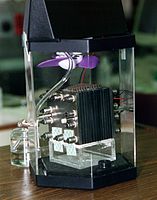
Photo from wikipedia
Abstract This paper compares three optimal hybrid energy system configurations, namely full-active, semi-active and passive, for the particular purpose of assessing the viability of utilizing the passive architecture in a… Click to show full abstract
Abstract This paper compares three optimal hybrid energy system configurations, namely full-active, semi-active and passive, for the particular purpose of assessing the viability of utilizing the passive architecture in a three-wheel electric vehicle composed of a fuel cell (FC) and a supercapacitor. In this respect, the characteristics of these configurations are investigated through three steps. Firstly, the mathematical model of each component is developed by employing experimental data. Subsequently, the optimal size of each topology is determined by a two-step optimization approach. This approach is based on the optimized sizing of power sources, utilizing a metaheuristic optimization algorithm, and optimal power flow sharing between the sources with the aim of satisfying the requested power while declining the fuel consumption and enhancing the system’s lifetime. Finally, the best-achieved size of each architecture is compared in terms of trip cost, capital cost, and the system weight. The obtained results show that passive topology can reduce the trip cost by 14.8% and 6.4% compared to full-active and semi-active ones, respectively. However, the active architecture results in less degradation in the FC compared to the other two topologies. Also, a validation phase is done under a real driving profile and the results are further discussed.
Journal Title: Energy
Year Published: 2021
Link to full text (if available)
Share on Social Media: Sign Up to like & get
recommendations!